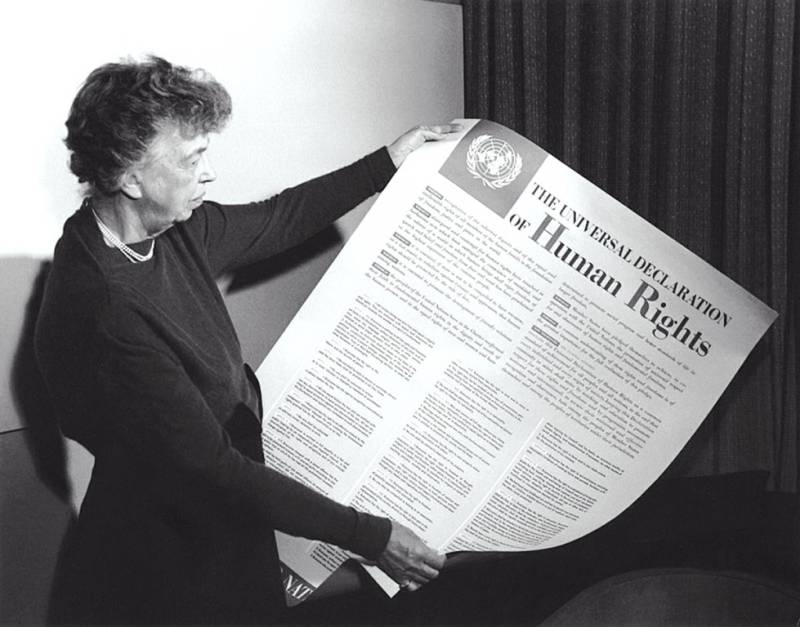
This photograph shows Eleanor Roosevelt holding a poster of the Universal Declaration of Human Rights (in English) in New York in November 1949.
The Universal Declaration of Human Rights (UDHR) is an international document adopted by the United Nations General Assembly that enshrines the rights and freedoms of all human beings. It was accepted by the General Assembly as Resolution 217 at its third session on 10 December 1948 at the Palais de Chaillot in Paris, France. Of the 58 members of the United Nations at the time, 48 voted in favour, none against, eight abstained, and two did not vote.
Considered a foundational text in the history of human and civil rights, the declaration consists of 30 articles detailing an individual’s “basic rights and fundamental freedoms” and affirming their universal character as inherent, inalienable, and applicable to all human beings. Adopted as a “common standard of achievement for all peoples and all nations,” the UDHR commits nations to recognize all humans as being “born free and equal in dignity and rights” regardless of “nationality, place of residence, gender, national or ethnic origin, colour, religion, language, or any other status.” The declaration is considered a “milestone document” for its “universalist language”, which makes no reference to a particular culture, political system, or religion.
It directly inspired the development of international human rights law, and was the first step in the formulation of the International Bill of Human Rights, which was completed in 1966 and came into force in 1976.
Although not legally binding, the contents of the UDHR have been elaborated and incorporated into subsequent international treaties, regional human rights instruments, and national constitutions and legal codes. All 193 member states of the United Nations have ratified at least one of the nine binding treaties influenced by the declaration, with the vast majority ratifying four or more. Some legal scholars have argued that because countries have consistently invoked the declaration for more than 50 years, it has become binding as part of customary international law, although courts in some nations have been more restrictive on its legal effect. Nevertheless, the UDHR has influenced legal, political, and social developments on both the global and national levels, with its significance partly evidenced by its 524 translations, the most of any document in history.

The Universal Declaration of Human Rights (UDHR) is an international document adopted by the United Nations General Assembly that enshrines the rights and freedoms of all human beings. It was accepted by the General Assembly as Resolution 217 at its third session on 10 December 1948 at the Palais de Chaillot in Paris, France. Of the 58 members of the United Nations at the time, 48 voted in favour, none against, eight abstained, and two did not vote.
Considered a foundational text in the history of human and civil rights, the declaration consists of 30 articles detailing an individual’s “basic rights and fundamental freedoms” and affirming their universal character as inherent, inalienable, and applicable to all human beings. Adopted as a “common standard of achievement for all peoples and all nations,” the UDHR commits nations to recognize all humans as being “born free and equal in dignity and rights” regardless of “nationality, place of residence, gender, national or ethnic origin, colour, religion, language, or any other status.” The declaration is considered a “milestone document” for its “universalist language”, which makes no reference to a particular culture, political system, or religion.
It directly inspired the development of international human rights law, and was the first step in the formulation of the International Bill of Human Rights, which was completed in 1966 and came into force in 1976.
Although not legally binding, the contents of the UDHR have been elaborated and incorporated into subsequent international treaties, regional human rights instruments, and national constitutions and legal codes. All 193 member states of the United Nations have ratified at least one of the nine binding treaties influenced by the declaration, with the vast majority ratifying four or more. Some legal scholars have argued that because countries have consistently invoked the declaration for more than 50 years, it has become binding as part of customary international law, although courts in some nations have been more restrictive on its legal effect. Nevertheless, the UDHR has influenced legal, political, and social developments on both the global and national levels, with its significance partly evidenced by its 524 translations, the most of any document in history.


